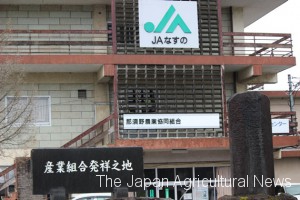Continuous birth of Credit cooperatives

100 anniversary monument of Shinagawa credit cooperatives which Yajirō Shinagawa established, and Tosuke Hirata took over (Odawara city, Tochigi prefecture).
It’s Yuzukami district, Odawara city, Tochigi Prefecture. Monument of black granite written as ” Birthplace of Sangyokumiai (cooperatives)” stands in front of the southern food center of JA Nasuno, near the intersection of National Highway 400.
The monument was built to celebrate that Yajirō Shinagawa and Tosuke Hirata established Shinagawa Shinyokumiai (credit cooperatives) at this place in 1894 (Meiji 27). The former Yuzukami village nogyokyodokumiai (agricultural cooperatives) built to commemorate the cooperatives 100th anniversary in 1995 (Heisei 7).
In April 1886 (Meiji 19), Shinagawa, in charge of Taifu clerk of Ministry of Agriculture and Commerce at that time, received state-owned land and embarked on cultivation of it as “Shinagawa farm” by collecting scholars familiar with the agricultural technology. Shinagawa established Shinagawa credit cooperatives with farm employee as cooperatives members in 1894 (Meiji 27). Heigoro Inoue, who was the caretaker of the farm, became the president.
According to Mr. Tatsumi Suzuki, who had worked at former Kasamatsu agricultural cooperatives (the predecessor of JA Nasuno) for 7 years since 1968 and currently serves as director of the JA (66 years old), at that time villagers drilled the moat and poured needed water from water sources of Nasu high ground into their own flat rice field. This is now called “Shinagawa moat” in the local area, and this moat is alive as Nasu-sosui (Nasu canal) even now. Underground their rice paddy fields, there were installed pipes in the basement 1 ~ 1.5m in the vertical and horizontal directions. The pipes collected water oozing from paddy fields and provided water to the fields again. The fields did not waste water.
After the death of Shinagawa, Hirata became single president. Hirata revised farm’s name into “Kasamatsu (Pine tree umbrella) farm”, after the large old Pine tree in the shape of an umbrella that was in the yard of the office. Then, Shinagawa credit cooperatives changed its name into Kasamatsu credit cooperatives, Kasamatsu credit purchasing and sales cooperatives, and Kasamatsu sangyokumiai (cooperatives), leading to the post-war nogyokyodokumiai (agricultural cooperatives).
Nationwide spread before promulgation of Sangyokumiai (cooperatives) law
Before the Shinyokumiai (credit cooperatives) bill was scrapped, in August 1890, Hirata, Director of Legislation Bureau of the Cabinet at that time, went back to hometown in Yonezawa city, Yamagata Prefecture.
At that time, in Yonezawa city, there was “Bukan-kai”, the organization of veterans who participated in the Boshin war. It was the friendship organizations where veterans talked memories at the shrine each other. Hirata was invited there, and preached the importance of the credit cooperatives. He also emphasized that it was essential cooperatives for industrial development of Yonezawa city that flourished in the textile.
There were some people who impressed to talk of Hirata and moved to the establishment of the cooperatives while calling their friends “Please agree with establishment by all means”. However, at that time, it was difficult for people knowing Tanomoshiko (mutual aid finance) or Goningumi (Five-family unit) to understand the purpose of the credit cooperatives. 4 years later, the founders were determined, and the inaugural meeting was held in 1894 (Meiji 27).
While appealing of participation, the prospectus claimed the benefits of the credit cooperatives as follows;
1) benefits to make big money by saving small money in future, 2) benefits to be able to borrow the capital for business in low interest rate, 3) benefits to cultivate the spirit of self-management and enforce the independent life, 4)benefits to inspire the activities of saving and diligence, 5) benefits to increase the interpersonal trust.
◇
Owing to efforts of Shinagawa and Hirata, in line with the Shinyokumiai (credit cooperatives) bill that was scrapped, Kakegawa credit cooperatives was born as the first credit cooperatives of our country. In addition, credit cooperatives of Mitsuke Hotokusha Rengo, Okitsu, Mitsukawa, Shimizu were established one after another in Shizuoka Prefecture.
The following year, in Yamagata prefecture, Komatsu- daiichi, Kasume, Komatsu-daini, and Yonezawa credit cooperatives were organized. Also in Tochigi prefecture, Yasaka, Kasamatsu, and Nakamura credit cooperatives were organized. Then, the movement of establishment spread in Kumamoto, Okayama, Kyoto, Tokyo, Osaka, also in Hiroshima prefecture. According to the survey by the Ministry of Agriculture and Commerce in 1898 (Meiji 31), there were 93 cooperatives which had the name of “Shinyokumiai” before promulgation of Sangyokumiai (cooperatives) Law. In addition, there were 51 cooperatives which had other name such as “Bichikukumiai (reserving cooperatives)” or “Chokinkumiai (saving cooperatives)” different from the name of “Shinyokumiai”.

